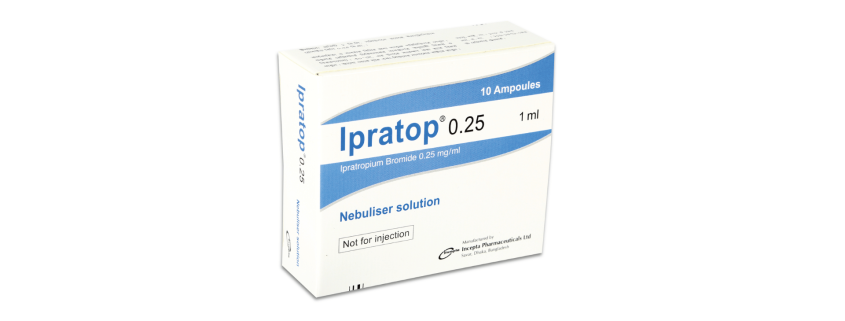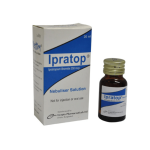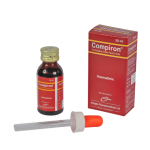Ipratop Nebuliser Solution(Ipratropium Bromide)

Therapeutic Group: Respiratory
Presentation
Description
Ipratropium Bromide is a quaternary ammonium compound with anticholinergic properties. It appears to inhibit vagal reflexes by antagonising the action of acetylcholine (the transmitter agent released from the vagus nerve). Anticholinergics prevent the increase in intracellular concentration of cyclic guanosine monophosphate (cyclic GMP) caused by interaction of acetylcholine with the muscarinic receptor on bronchial smooth muscle.
Indications
Ipratropium Bromide is indicated as a bronchodilator for maintenance treatment of bronchospasm associated with chronic obstructive pulmonary disease, including chronic bronchitis and emphysema. Ipratropium bromide is indicated, when used concomitantly with inhaled beta2-agonists, for treatment of reversible airways obstruction as in acute and chronic asthma.
Dosage & Administration
Adults and children over 12 years of age:
0.25 – 0.5 mg (1 ml-2 ml of solution) 3 to 4 times daily.
For treatment of acute bronchospasm, 0.5 mg (2 ml) of solution.
Children 6-12 years of age:
0.25 mg (1 ml) up to a total daily dose of 1 mg (4 ampoules).
Children 0-5 years of age:
0.125-0.25 mg (0.5-1 ml of solution) up to a total daily dose of 1 mg (4 ampoules).
Ipratropium bromide should be administered no more frequently than 6 hourly in
children under 5 years of age.
The dose of nebuliser solution may need to be diluted to obtain a final volume suitable for the nebuliser being used (usually 2-4 ml); if dilution is necessary use only sterile
sodium chloride 0.9% solution.
Side Effects
Allergic-type reactions such as skin rash, angio-oedema of the tongue, lips and face, urticaria (including giant urticaria), laryngospasm and anaphylactic reactions have been reported, with positive rechallenge in some cases.
Precautions
Ipratropium Bromide should be used with caution in patients predisposed to narrow-angle glaucoma, or with prostatic hyperplasia or bladder-neck obstruction.
Use in Pregnancy & Lactation
The safety of Ipratropium Bromide during human pregnancy has not been established. The benefits of using Ipratropium Bromide during a confirmed or suspected pregnancy must be weighed against possible hazards to the unborn child. It is not known whether Ipratropium Bromide is excreted into breast milk.
Drug Interaction
The risk of acute glaucoma in patients with a history of narrow-angle glaucoma may be increased when nebulised ipratropium bromide and beta2-agonists are administered
simultaneously
Over Dose
Palpitation and increases in heart rate have been produced with inhaled doses of 5 mg. Severe overdose is characterized by atropine-like symptoms like tachycardia, tachypnea, high fever and central effects like restlessness, confusion and hallucinations.
Storage
Do not store above 30 degree Celsius. Keep away from light and out of the reach of children.
Commercial Pack
Ipratop 0.25 Nebuliser Solution: Each box contains 2 blister strips of 5 ampoules.



